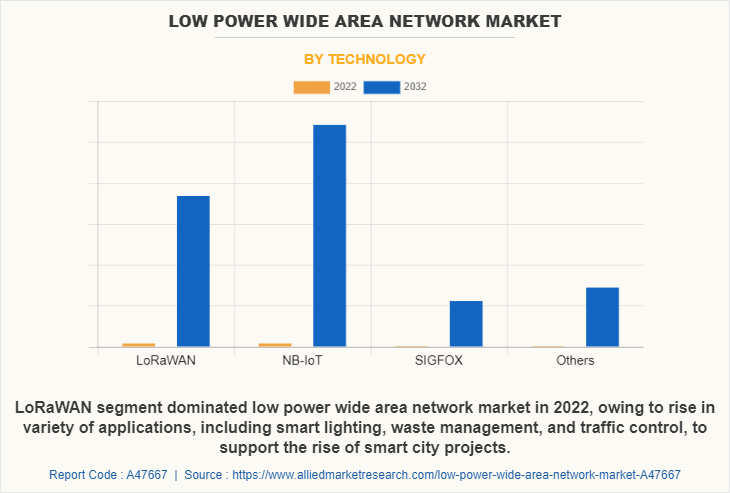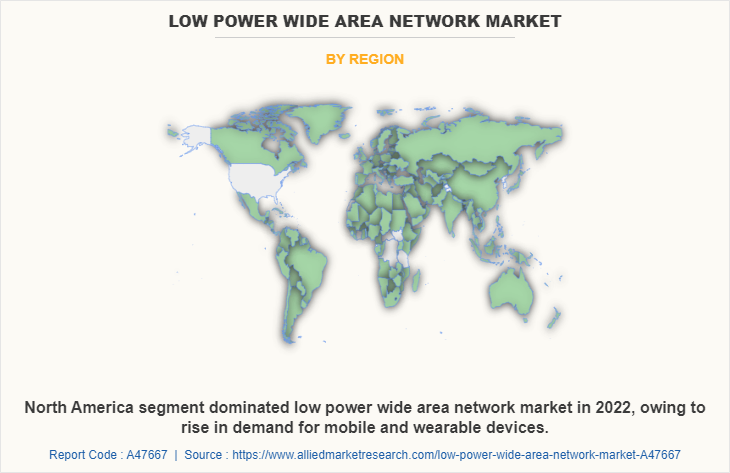Low Power Wide Area Network Market Statistics, 2032
The global low power wide area network market size was valued at $8.2 billion in 2022, and is projected to reach $582 billion by 2032, growing at a CAGR of 53.4% from 2023 to 2032.
Moreover, factors such as increase in demand for smart city initiatives and real-time monitoring and control of assets primarily drive the growth of the low power WAN market. However, security concerns with limited band width hamper the market growth. Additionally, increase in demand for smart agriculture is expected to provide lucrative opportunities for the market growth during the forecast period.

Low-power wide-area network (LPWAN) refers to a specific type of network that enables low bit-rate, long-distance communication. It is a wireless technology that connects low-power devices over considerable distances at slow data speeds. Devices that need a lot of battery life and can send data over large distances are expected to benefit from low-cost, low-power, and wide-area connection provided by LPWANs. In addition, decline in LPWAN technology costs is anticipated to drive the market for low power wide area network growth.
Due to the rise in demand for low-power wide area connectivity for Internet of Things devices, the LPWAN market is anticipated to expand rapidly in upcoming years. Agriculture, healthcare, logistics, and transportation are a few industries that implement the LPWAN technology. The development of smart cities and smart buildings is expected to present more opportunities for the low power wide area network market to expand in the upcoming years. The lack of global LPWAN standards, however, is anticipated to impede the expansion of the market for low power wide area networks in the near future.
The low power wide area network market is segmented on the basis of technology, application, end user, and region. On the basis of technology, it is segregated into LoRaWAN, NB-IoT, Sigfox, and others. On the basis of application, it is divided into smart building, smart agriculture, smart waste management, smart gas and water monitoring, smart parking, and others. On the basis of end user, it is divided into oil and gas, industrial manufacturing, agriculture, consumer electronics, transportation and logistics, healthcare, and others. Region-wise, it is analyzed across North America, Europe, Asia-Pacific, and LAMEA.
The global low power wide area network industry is dominated by key players such as Semtech Corporation, Loriot Ag, Nwave, Sigfox, Waviot, Actility, Ingenu Inc., Link Labs, Senet, ATandT Intellectual Property. These players have adopted various strategies to increase their market penetration and strengthen their position in low power wide area network industry.

On the basis of technology, LoRaWAN segment dominated the low power wide area network market size in 2022, and is expected to maintain its dominance in the upcoming years owing to growing need for low-cost, low-power connectivity solutions, which LoRaWAN technology offers, as IoT devices and applications are used more widely propels the market growth significantly. However, NB-IoT segment is expected segment is expected to witness highest growth, owing the advancement of NB-IoT technology has given cellular network operators access to brand-new commercial prospects.

North America is anticipated to account for the largest share of the low power wide area network market growth during the forecast period, owing to presence of a substantial industrial base in the U.S., government initiatives to promote innovation, and large purchasing power. The growth is primarily concentrated in the U.S. Companies owing to rise in demand for mobile and wearable devices and growing need for IoT devices in North America is one of the main potentials for LPWAN. However, Asia-Pacific is expected to exhibit the highest growth during the forecast period, owing to factors such as urbanization, industrialization, rise in need for automation and digitalization. IoT applications in industries including smart cities, agriculture, logistics, and healthcare are perfect for LPWAN technology.
Top Impacting Factors
Increase in Demand for Smart City Initiatives
Initiatives for "smart cities" are designed to make city services more effective while boosting the quality of life for residents. LPWAN technology, which offers affordable and energy-efficient wireless connectivity for a large number of devices, is essential to make smart city efforts possible. The vendors of smart city services believe that package for smart city solutions should contain devices for vehicle-to-vehicle and vehicle-to-infrastructure communication.
Moreover, the low power wan market for smart city solutions is set to rise as investments in bringing urban communications networks up to 5G standards spur growth in the digitization of city infrastructure and services. Real-time monitoring of numerous city functions, such as traffic control, waste disposal, and environmental monitoring, is made possible via LPWAN. LPWAN can also be used to monitor public safety, track assets, and enhance building energy. The global adoption of smart city initiatives is anticipated to fuel the low power WAN market growth.
Real-time Monitoring and Control of Assets
LPWAN technology is particularly suitable for real-time monitoring and control of assets such as industrial equipment, agricultural machinery, and vehicles. For example, LPWAN can be used to monitor the condition of a machine in a factory, enabling predictive maintenance and reducing downtime. By monitoring the machine's performance in real-time, businesses can identify potential issues before they become major problems, thereby reducing the risk of unplanned downtime and costly repairs. In addition, LPWAN can be used to track the location of vehicles, optimize routes, and monitor driver behavior.
Real-time monitoring of vehicle location and driver behavior can help businesses optimize their fleet management operations, reduce fuel consumption, and improve driver safety. For instance, LPWAN can be used to monitor driver behavior, such as harsh braking or acceleration, and provide real-time feedback to the driver, encouraging safe driving practices. In the agriculture industry, LPWAN can be used to monitor soil moisture levels, temperature, and other environmental factors to optimize crop growth and yield.
By providing real-time data on crop conditions, farmers can make informed decisions on irrigation, fertilization, and other inputs, thereby reducing waste and improving crop yield. LPWAN can also be used to monitor livestock, providing real-time data on health and behavior, enabling early detection of potential health issues. In conclusion, real-time monitoring and control of assets is a significant driver of the LPWAN market growth. LPWAN technology provides a cost-effective and energy-efficient solution for connecting devices over long distances, making it ideal for IoT applications in various industries. LPWAN enables businesses to optimize their operations, reduce costs, and improve efficiency by providing real-time data on asset conditions and performance.
Key Benefits for Stakeholders
- This report provides a quantitative analysis of the market segments, current trends, estimations, and dynamics of the low power wide area network market analysis from 2022 to 2032 to identify the prevailing low power wide area network market forecast.
- The low power wan market research is offered along with information related to key drivers, restraints, and opportunities.
- Porter's five forces analysis highlights the potency of buyers and suppliers to enable stakeholders make profit-oriented business decisions and strengthen their supplier-buyer network.
- In-depth analysis of the low power wide area network market share to determine the prevailing market opportunities.
- Major countries in each region are mapped according to their revenue contribution to the global low power wan market.
- Market player positioning facilitates benchmarking and provides a clear understanding of the present position of the market players.
- The report includes the analysis of the regional as well as global low power wide area network market trends, key players, market segments, application areas, and market growth strategies.
Low Power Wide Area Network Market Report Highlights
| Aspects | Details |
| Market Size By 2032 | USD 582 billion |
| Growth Rate | CAGR of 53.4% |
| Forecast period | 2022 - 2032 |
| Report Pages | 277 |
| By Technology |
|
| By Application |
|
| By End User |
|
| By Region |
|
| Key Market Players | Sigfox, Senet, Loriot AG, AT&T Intellectual Property, Nwave, Actility, Link Labs, Ingenu Inc., Semtech Corporation, WAVIoT |
| | Wavlot, Verizon Communications Inc. |
Analyst Review
he low power wide area network (LPWAN) market is anticipated to expand rapidly in the upcoming years due to the rise in need for IoT applications across numerous industries, including healthcare, transportation, and agriculture. It is suitable for IoT applications in numerous industries as it works well for remote sites and low-power gadgets. In the upcoming years, the demand for smart city initiatives, real-time asset monitoring, and asset control is expected to fuel the growth of the LPWAN market.
LPWAN technology is the best choice for remote areas and low-power devices as it offers a practical and economical method of tying together devices over long distances. Increase in acceptance of smart city projects and demand for real time asset monitoring and management are factors that drive the market growth. Moreover, due to their sophisticated infrastructure and widespread use of IoT technology, North America and Europe are anticipated to dominate the market.
However, owing to the rise in need for smart city solutions and presence of significant manufacturing hubs, the Asia-Pacific region is anticipated to experience the highest growth in upcoming years. Sigfox, LoRa Alliance, Ingenu, and NB-IoT are some of the leading companies in the LPWAN market.
Increase in demand for smart city initiatives and real-time monitoring and control of assets are the upcoming trends of Low Power Wide Area Network Market in the world.
Increase in demand for smart agriculture is the leading application of Low Power Wide Area Network Market
North America is the largest regional market for Low Power Wide Area Network
The global low power wide area network market was valued at $8,241.93 million in 2022 and is projected to reach $5,82,035.47 million by 2032, registering a CAGR of 53.4% from 2022 to 2032.
Market players operating in the LPWAN market include Semtech Corporation, Loriot Ag, Nwave, Sigfox, Waviot, Actility, Ingenu Inc., Link Labs, Senet, ATandT Intellectual Property. Furthermore, it highlights the strategies of the key players to improve the market share and sustain competition.?
Loading Table Of Content...
Loading Research Methodology...



